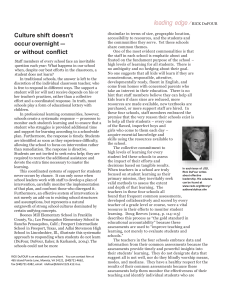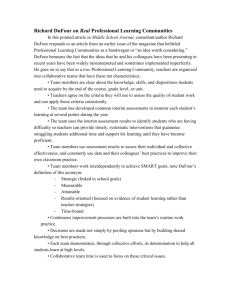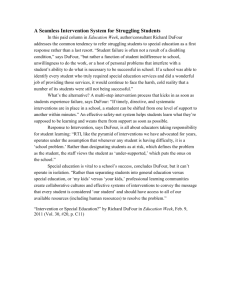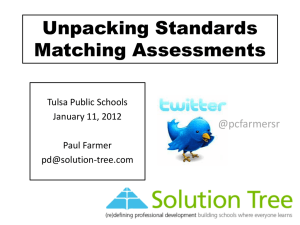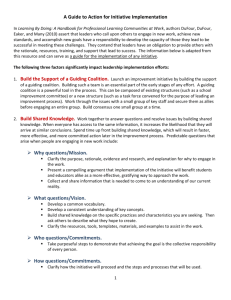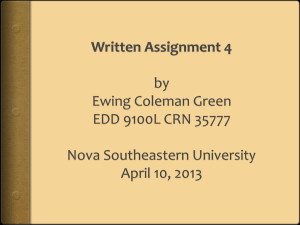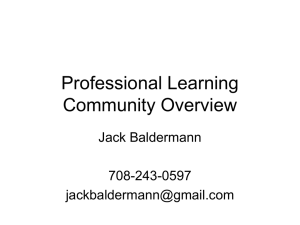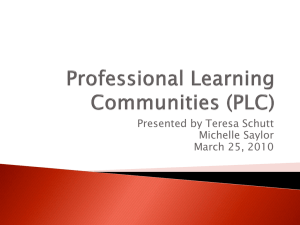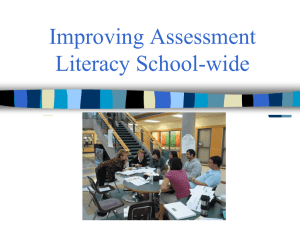Inver GroveSD_2blackline (2.45MB PPT)
advertisement
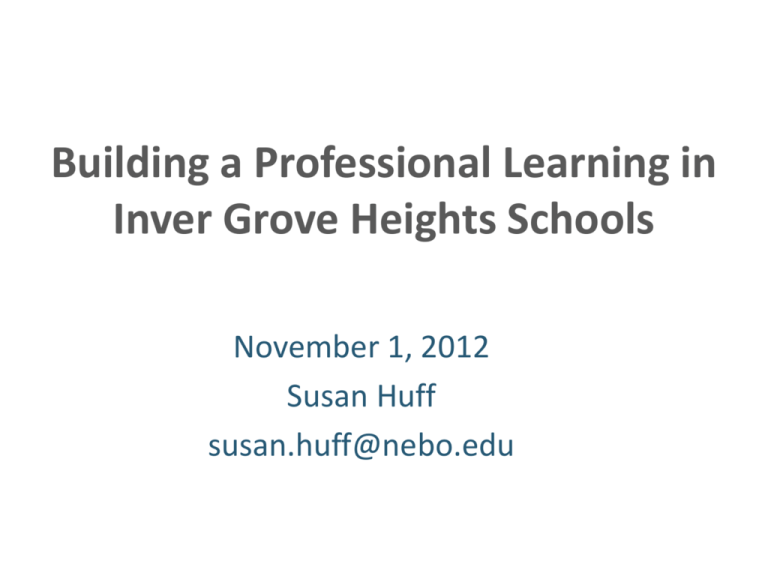
Building a Professional Learning in Inver Grove Heights Schools November 1, 2012 Susan Huff susan.huff@nebo.edu Transforming a school to a professional learning community is a journey that takes time and effort. Three objectives: • Review the big picture of a professional learning community • Confirm great things happening at your individual schools • Look for areas of growth Norms for Us • • • • Listen to learn and apply Participate fully Paraphrase, clarify Focus--pay attention to signal What is a PLC? “Educators committed to working collaboratively in ongoing processes of collective inquiry and action research in order to achieve better results for the students they serve. PLC’s operate under the assumption that the key to improved learning for students is continuous, job-embedded learning for educators.” (DuFour, DuFour, Eaker, & Many, 2006) Why PLCs? “Throughout our ten-year study, whenever we found an effective school or an effective department within a school, without exception that school or department has been a part of a collaborative professional learning community.” (Milbrey McLaughlin) 3 Big Ideas of PLC • Unwavering focus on student learning • Collaborative teaming • A results orientation (DuFour & Eaker, 1998) Four Crucial Questions: (DuFour, 2006) • What do we want each student to learn? • How we will know when each student has learned it? • How will we respond when a student experiences difficulty in learning? • How can we enrich and extend their learning when they already know it? In a professional learning community the focus shifts from ensuring that students are taught to ensuring that students learn. (Bryk et al., 1999; Newmann & Wehlage, 1995; Hord 1997; Louis et al., 1996) A professional learning community is dependent upon a culture of collaboration, where teachers must have embedded time for frequent, structured collaboration among teachers on the same grade level or teaching the same content. (DuFour, 2007) Focus on results: • Goal and results orientation • Common assessments that hold all students to a common standard • Data-based decision making • Formative and summative assessments • Collective reflection on current reality “There is clear consensus among leading educational researchers as to the best practices for improving schools. When staff work together as a professional learning community– when they work together to clarify purpose and priorities, establish and contribute to collaborative teams, participate in continuous improvement cycles of gathering data on student achievement, identify areas of concern, generate strategies for improving students’ performance . . . . . . support each other as they implement those strategies, and gather new data to assess the impact of their collective efforts– and when they are relentless in their efforts to improve achievement for all students, they increase the likelihood of sustained, substantive school improvement. The research is clear and compelling on this point.” (DuFour, 2003) Nebo’s Non-Negotiables for all schools . . . all teams • • • • Team Norms “I Can” Statements for Student Learning Common Curriculum Map Common Formative Assessment for Each “I Can” Statement • Data Assessment • SMART Goals Here’s what . . . why . . . how. . . • • • • • Essential concepts / common curriculum Common assessments Collaboration Data analysis SMART Goals Module 1 Essential Concepts & Common Curriculum Focus on Learning 1. What do students need to learn? 2. How do we know they know it? 3. What are we going to do if they don’t get it? 4. What are we going to do if they already know it? Focus on Results Collaborative Culture Here’s what . . . “What knowledge, skills, and dispositions should each student acquire as a result of this course and each unit of instruction within this course?” (DuFour, DuFour, Eaker, & Many, 2006, p. 43) -a guaranteed and viable curriculum- Here’s why . . . As teachers assume collective responsibility for student learning, what unites them is a common curriculum. (Lee, Smith, & Croninger,1995) Here’s why . . . A common curriculum eliminates the instructional lottery that results when teachers are free to teach whatever they desire. (McLaughlin & Talbert, 2001) Here’s why . . . Without a common curriculum, any individual student’s chance of receiving standards based curriculum depends on which teacher he draws in the lottery of class or teacher assignments. (McLaughlin & Talbert, 2001) Here’s how . . . Understanding By Design (UbD) 1. Identify desired results. (What do we want students to know and be able to do? Standards . . . Outcomes) 2. Determine acceptable evidence. (Assessment) 3. Plan learning experiences and instruction. (Design lessons) (Wiggins & McTighe, 2005) Marzano: • Intended Curriculum – State standards – District curriculum adoptions • Implemented Curriculum – Curriculum taught by teacher • Attained Curriculum – Curriculum learned by the student Criteria for Identifying Essential Common Outcomes • ENDURANCE – – are students expected to retain the skills/knowledge long after the test is completed • LEVERAGE – – is this skill/knowledge applicable to many academic disciplines • READINESS FOR THE NEXT LEVEL OF LEARNING – – is this skill/knowledge preparing the student for success in the next grade/course (Reeves, 2005) Protocol to Clarify & Address Priority Standards (Erkens, 2012) 1. Examine all of your state standards. 2. Deconstruct standards for team clarity. 3. Identify your power standards using three criteria: endurance, leverage, readiness. 4. Reach team consensus on power standards. 5. Document standards, including recorded numbers and letters of selected standards. 6. Check for vertical alignment and sequence standards. 7. Identify targets within standards. 8. Design assessments to align. 9. Identify curriculum materials to support required learning, to address standards, and to help learners be successful on assessments. 10. Identify instructional strategies that will best help you teach the curriculum. Module 2 Common Assessments Focus on Learning 1. What do students need to learn? 2. How do we know they know it? 3. What are we going to do if they don’t get it? 4. What are we going to do if they already know it? Focus on Results Collaborative Culture Here’s what . . . Common ongoing formative team-made assessments made from multiple sources given by a team of teachers with the intention of collaboratively examining the results for • shared learning • instructional planning for individual students • curriculum, instruction, and/or assessment modifications Here’s why . . . Team-developed common assessments: • Are more efficient. • Promote equity. • Monitor and improve student learning. • Inform and improve the practice of individual teachers and teams of teachers. • Build team capacity to achieve at higher levels. • Are essential to systematic interventions when students do not learn. (DuFour, DuFour, Eaker, 2008) Here’s why . . . Team-developed common assessments: • Increase accuracy and reliability. • Promote continued development of assessment literacy for teachers. • Increase collective efficacy. (Cassandra Erkens) Formative vs. Summative It isn’t the method that determines whether the assessment is summative or formative, it is how the results are used. Here’s how . . . to write CAs • Teacher teams write new assessments based on standards. • Teams use multiple sources for assessment items (parts of textbook assessments, parts of computer test item pools, as appropriate). • Teams revise assessments for future use as they evaluate their effectiveness. Sample common assessment – usually about 10 questions. Name ______________ Write the number sentence you would use to solve the problem. 1. Kelsy went to the store and bought 56 pencils. She broke 20 of them. How many did she have left? 2. In the park there were 7 trees. Each tree had 4 branches. How many branches did the trees have in all? 3. Mr. Fox has 5 tables in his room. 3 students sit at each table. How many students does Mr. Fox have in all? 4. Pete bought 14 mice at the pet store to feed his snake. He went back and bought 9 more. How many mice did Pete buy altogether? 5. We learned 18 cursive letters before Christmas and 22 after. How many cursive letters have we learned in all? Teamwork before and after common assessments Process for Common Assessments Create a plan for appropriate interventions. Establish team norms for collaboration. Identify 8–10 big ideas per semester. Tally and review common assessment results. Monitor for learning of individual and collective results. Revise curriculum, instruction, and assessments as needed. Examine school data and establish SMART goals. Create a road map of CAs and targets. Monitor progress on SMART goals. Provide instruction and ongoing assessment. Assess again— monitoring for results. Repeat intervention loop as needed. Provide instruction and ongoing assessment. Identify the targets of the assessments Design formative and summative assessments. Erkens 1 1 Here’s how . . . to use CAs Seek evidence of student learning: • What does this student work tell us about what students know and can do? • What does this student work tell us about what students are still missing? • What indicators, if any, offer insight into student misconceptions and highlight potential intervention strategies? Common Assessments Reflections 1. Discuss the assessment task with team. 2. Examine data and identify areas for team discussion. -As a team: Which learning targets from the assessment require more attention? -As a team: Which students require additional support? -As an individual teacher: Which area was my lowest, and how can I improve? -As a team or individual: Which students did not master which targets? 3. What is your team’s plan of action to address results? Module 3 Collaboration Here’s what . . . Collaboration Defined A systematic process in which we work together, interdependently, to analyze and impact professional practice in order to improve our individual and collective results. (DuFour, DuFour, & Eaker, 2007) What is a team? “A group of people working interdependently toward a common goal for which members are mutually accountable.” (DuFour, 2007) Here’s why . . . Improving schools requires collaborative cultures. Without collaborative skills and relationships, it is not possible to learn and to continue to learn as much as you need to know to improve. (Michael Fullan) Here’s why . . . Creating a collaborative culture is the single most important factor for successful school improvement initiatives and the first order of business for those seeking to enhance the effectiveness of their schools. (Eastwood & Lewis) Here’s why . . . Enhanced teaching and learning result through collaboration. (Peterson, McCarthey, & Elmore, 1995; Fullan, 1993; McLaughlin & Talbert, 2001; Kruse, Louis, & Bryk, 1994, Bryk; Camburn, & Louis, 1999; Newmann, 1994; Newmann & Wehlage, 1995; Lee, Smith, & Croninger, 1995; Sebring, Bryk, Easton, Luppescu, Thum, Lopez, & Smith, 1995; Shellard, 2004) Here’s how: create teams “The best team structure is simple: a team of teachers who teach the same course or grade level.” (DuFour, DuFour, Eaker, & Many, 2006, p. 93) Here’s how . . . Make Teams Effective • Embed collaboration in routine practices of the school with focus on learning. • Time for collaboration is built into the school day and school calendar. • Products of collaboration are made explicit. (More Keys to Effective Teams) • Team norms guide collaboration. • Teams focus on key questions. • Teams pursue specific and measurable performance goals. • Teams have access to relevant information. (DuFour, DuFour, & Eaker) Here’s how . . . Structure time for the work of collaborative teams. (see Simple Ways Schools Find Time to Work Together) Here’s how . . . Focus on the right things “The fact that teachers collaborate will do nothing to improve a school. The pertinent question is not, ‘Are they collaborating?’ but rather, ‘What are they collaborating about?’” (DuFour, DuFour, Eaker, & Many, 2006, p. 91) Unfocused Collaboration . . . • May be instruments for preserving the status quo, inhibiting analysis and innovation. • May mutually reinforce poorly formed habits. • May force teachers to consider beliefs and practices based on bad practice. • May be about storytelling—mostly complaint. (Little, 1990) • • • • The 4 Crucial Questions focus collaboration on the right things: What is it we want our students to learn? How will we know if each student has learned it? How will we respond when some students do not learn it? How can we extend and enrich the learning for students who have demonstrated proficiency? (DuFour, DuFour, Eaker, & Many, 2006) Structural Conditions • Time to Meet • Team Norms • Team Focus • Team Accountability (see Collaboration Agenda and Leader/Scribe Assignments) Team collaboration binder • • • • • • • • Team Norms Facilitator/Scribe Assignments Team’s Daily Schedule Collaboration Agenda (one for each week’s collaboration) Curriculum Maps Essential Learning Outcomes (or Power Standards) Copy of Core Curriculum Copies of Team’s Common Assessments A focus on learning With collaborative teams. Results orientation They’re our school’s dreams. We intervene early With more time and support. There’s curriculum mapping On which we consort. Teams’ common assessments Every student will take. We analyze data, Then decisions we make. A focus on learning. You’re on a great team. Results orientation— It’s not just a dream! Module 4 Collaborative Data Analysis Here’s what . . . • To change data to information, we need a basis of comparison. • Data must be easily accessible. • Data must be openly shared. (DuFour, Dufour, & Eaker) Here’s what . . . Sources of data PLCs use: • Assessment data Standardized tests (knowledge check-up, G/T identification; compare to other schools in the nation) Criterion-referenced tests Unit tests / quizzes / assignments Ongoing assessments / running records Rubrics tied to student work or product • Perception data Opinion surveys, needs surveys; indicators of school quality survey • Statistical data SES, ESL, mobility, ethnicity, attendance & punctuality, office referrals & discipline, graduation rates Here’s why . . . Collaboratively examining student work promotes collective responsibility for student learning. (Langer, Colton, & Goff, 2003; Dearman & Alber, 2005) Here’s why . . . When teachers engage in this collaborative activity, they must agree on common proficiency standards for student work. This reduces variation among teachers about whether student work meets the standard. (Langer, Colton, & Goff, 2003) Here’s how . . . we do it at Spanish Oaks 1. Teachers identify a target learning area. 2. Teachers determine standards that will be taught. 3. Teachers select or design a common assessment to measure mastery of that standard and a pre-assessment. 4. Teachers give pre-assessment and group students for more time and support. 5. Teachers then share instructional materials and collaborate on best practices to teach the concept. 6. At the end of the agreed upon instructional period, each teacher gives the common assessment within the same window of time. 7. The assessment results are then brought to the team for analysis. 8. The group makes a plan to help each student improve who has not yet met the standard. Concept: 2-digit Multiplication with a 2-digit Multiplier Student 1 2 3 4 5 6 7 8 9 10 11 12 13 14 15 16 17 Class1 10 10 9 8 10 10 10 9 10 10 9 10 10 10 10 10 9 Class 2 10 10 10 8 10 10 10 10 10 10 10 10 10 10 10 10 9 Class 3 10 10 9 8 7 7 9 9 8 7 7 10 10 10 9 9 9 Class 4 10 10 9 6 9 7 10 10 6 9 10 7 8 10 10 Ave 9.7 9.8 8.7 8.7 Concept: 2-digit Multiplication with a 2-digit Multiplier Mr. Jones Miss Ruiz Mrs. Smith Mr. Terry Reteach Practice/Enrich Rene (8) Enrich 1. Rebecca 10 1. Rodney 10 1. Luis 10 1. Alex 10 Brian Cindy 2. John 10 2. Rebecca 10 2. Tom 10 2. Jack 10 Katelyn Melissa (8) Samantha 3. Jose 9 3. George 10 3. Sydney 9 3. Luke 9 Lydia Ryan C. (8) Trudy 4. Rene 8 4. Melissa 8 4. Ryan C. 8 4. Lauren 6 Brent Marisa (8) Walter Natalie (8) Lucky 5. Joshua 10 5. Angelica 10 5. Brian 7 5. Beverly 9 Lauren 6. Helen 10 6. Edgar 10 6. Katelyn 7 6. Will 7 Will Rodney Randy 7. Antonio 10 7. Eduardo 10 7. Sam 9 7. Max 10 Jessica Rebecca Alex 8. Oliver 9 8. Simone 10 8. Jared 9 8. Christian 10 Liz George Jack 9. Libby 10 9. Elizabeth 10 9. Marisa 8 9. Jessica 6 Angelica Luke 10. Kaitlyn 10 10. Trent 10 10. Lydia 7 10. Ben 9 Edgar Beverly 10 11. Brent 7 11. Rachel O 10 Eduardo Max 11. Tim 9 11. Ryan H. 12. Roger 10 12. Cindy 10 12. Gina 10 12. Liz 7 Simone Christian 13. Wendy 10 13. Samantha 10 13. Lexie 10 13. Natalie 8 Elizabeth Ben 14. Marisole 10 14. Trudy 10 14. Carter 10 14. Camille 10 Trent Rachel O. 15. Andrew 10 15. Walter 10 15. Wyatt 9 15. Alisa 10 Ryan H. Camille 16. Rachel T 10 16. Lucky 10 16. Nicole 9 17. Georgia 9 17. Randy 9 17. Maggie Alisa + Jones’ class 9 + Smith’s class Teacher Average 9.7 9.8 8.7 8.7 Ruiz Jones Smith Power Standards / ELOs 1. Endurance 2. Leverage 3. Essential for the next level of instruction. (Reeves, 2005) Keys to Formative Assessment • “Is it used to identify students who are experiencing difficulty in their learning? • Are students who are having difficulty provided with additional time and support for learning? • Are students given an additional opportunity to demonstrate their learning?” (DuFour keynote at PLC Institutes 2007, p. 80) Module 5 SMART Goals SMART Goals contribute to a results orientation. • Strategic and specific • Measurable • Attainable • Results-oriented • Time-bound (O’Neill & Conzemius, 2006) Here’s what . . . “Strategic goals are linked to strategic priorities that are part of a larger vision of success for the entire school district. Strategic and specific means that these goals will have both broad-based and long-term impact because they are focused on the specific needs of the students for whom the goal is intended.” (Conzemius & O’Neill, 2002, p. 4) Here’s what . . . “Measurable means being able to know whether actions made the kind of difference we wanted: being able to measure a change in results because of those actions.” (Conzemius & O’Neill, 2002, p. 5) Here’s what . . . Attainable means a goal is within the realm of our influence of control, and doable given current resources. (Conzemius & O’Neill, 2002) Here’s what . . . Results-oriented means goals are aimed at specific outcomes that can be measured or observed. They define what is expected and a desired end point. • student achievement • % of students who improve • learning that can be defined and measured (Conzemius & O’Neill, 2002) Here’s what . . . Time-bound means agreeing on a time frame for achieving the goal to keep it a priority and give it some urgency. (Conzemius & O’Neill, 2002) Here’s why . . . Goals represent measurable commitments that can be used to assess progress toward the vision. (DuFour & Eaker, 1998) Here’s why . . . “SMART goals help us monitor which of our efforts are making a difference and by how much.” (Conzemius & O’Neill, 2002, p. 5) Here’s why . . . When we establish clear learning goals, the effect on student achievement can be as much as a 41 percentile gain. (Marzano, What Works in Schools, 2003) Here’s how . . . Tips for Writing Goals • Goals should be clearly linked to the vision. • Goals should be limited in number (five or fewer) to ensure focus. • Goals should focus on the desired outcome rather than on the means to achieve the outcome. (DuFour & Eaker, 2007) Here’s how . . . Ask broad questions . . . • In which areas of our tests were our students weakest? • What patterns do we see in the data? • What does disaggregated data tell us about our subpopulations (ethnicity, poverty, special education)? Is this a SMART goal? All the students in our grade level will demonstrate mastery of math facts. Students will leave first grade with a love of learning and a desire to become a productive citizen. Ninety-five percent of the students within our team will read on grade level as measured by our district benchmark reading assessment by May 2013. allthingsplc.info Check out my Google Site https://sites.google.com/ a/nebo.edu/susan-huff
